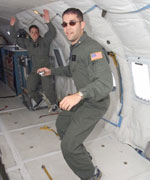
Image credit: UMich
One of the big problems with space travel is that one cannot over pack.
Suppose astronauts reach Mars. How do they explore the planet if they cannot weigh down the vessel with fuel for excursions?
A team of undergraduate aerospace engineering students at the University of Michigan is doing research to help astronauts make fuel once they get to Mars, and the results could bring scientists one step closer to manned or extended rover trips to the planet.
Their research proposal won the five-student team a highly competitive trip to NASA’s Johnson Space Center in Houston to participate in the Reduced Gravity Student Flight Opportunities Program.
In Houston, the students conducted zero-gravity experiments using iodine as a catalyst to burn magnesium. Magnesium is a metal found on Mars that can be harvested for fuel?fossil fuels don’t burn on Mars because of the planet’s carbon dioxide (CO2) atmosphere, but metals do burn in a CO2 atmosphere.
The idea for the students’ experiments evolved from previous research done by Margaret Wooldridge, an associate professor in mechanical engineering and the team’s adviser. Wooldridge’s research showed that while magnesium is a promising fuel source, burning magnesium alone?without a catalyst such as iodine?has several challenges. Preliminary results from the student experiments showed that using iodine as a catalyst helped make the magnesium burn better, said Arianne Liepa, aerospace engineering undergrad and team member.
The experiments also showed that using the iodine, magnesium, CO2 system worked even better in a microgravity environment. “That bodes well for a power source on Mars where the gravity is approximately one-third that of Earth,” Wooldridge said.
The students?Greg Hukill, Arianne Liepa, Travis Palmer, Carlos Perez and Christy Schroeder?who conducted the experiments over a nine-day period in March, flew on a specially modified Boeing KC 135A turbojet transport. The plane flies parabolic arcs to produce weightless periods of 20 to 25 seconds at the apex of the arc.
Original Source: University of Michigan News Release
